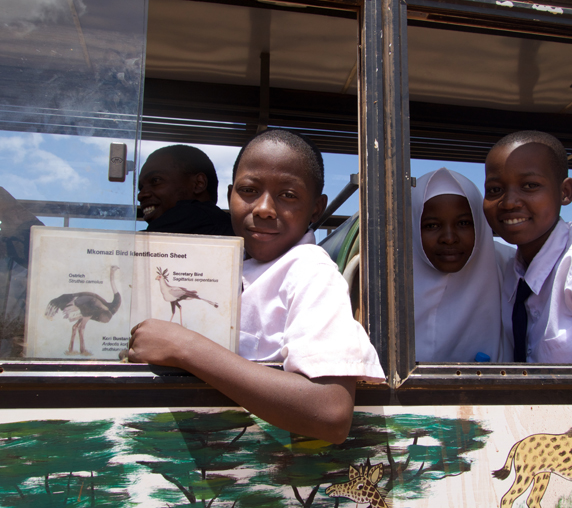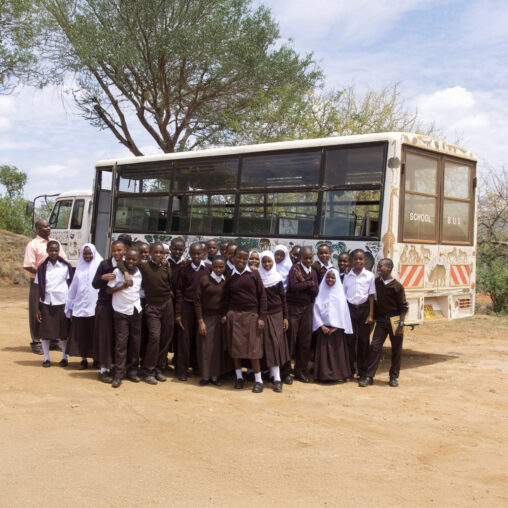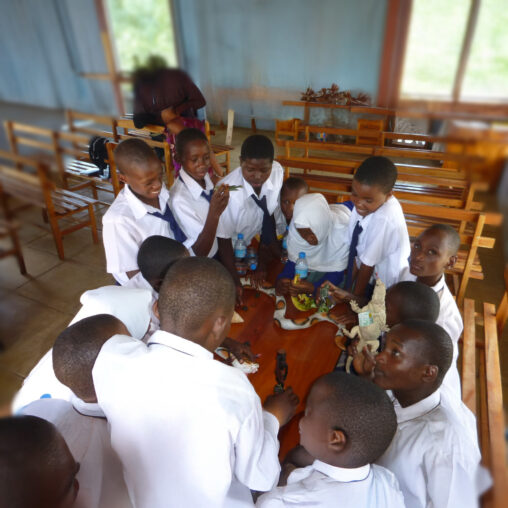Community Outreach
and Education
Our outreach programmes in Mkomazi included the construction of a secondary school with science labs, computer rooms, a headmaster’s house and staff quarters. As a result the village of Kisiwani had a secondary student population of over 300.
In the nearby village of Gonja, the Trust constructed an entire Vocational Training Centre fully equipped for 350 students. Classrooms and science labs were constructed in 20 other schools. The rhino sanctuary had an educational centre with full audio/visual equipment and educational materials. With the ‘Rafiki wa Faru’ environmental education programme, students arrived in a 28 seater bus staffed by our environmental educational officer. 800 schoolchildren, 150 school teachers and 100 elders and community leaders attended this programme every year.
For a detailed list of the Community Outreach Work undertaken by the Trust in Mkomazi click here.



Community Outreach and Education 1993-2019
The Mkomazi Outreach Programme was started in 1993 as a joint undertaking between the Trusts and the Wildlife Division of the Government of Tanzania. The programme was initially coordinated by two lay missionaries, Harrie Simons and the late Truus Nicolasen, who had by that time already lived in Kisiwani village for seven years. They had initiated a programme of self-help development on a long-term basis. Their work centred mainly on education, medical assistance, women’s groups, agricultural practices and water management. The women’s groups dedicated their time and resources to health, irrigation, education, agricultural and economic issues, as well as raising the status of women in the villages. Close cooperation with the local communities was vital for the sustainable development of this precious national resource, whilst addressing the critical needs of the communities where possible.
During the course of the outreach programme the Trusts were able to fund the construction of an entire secondary school (including 8 classrooms, 2 science labs, staff administration offices and a computer room) which was staffed by Government teachers. It was opened in 1999 by the Minister for Natural Resources and Tourism, Hon. Zakia Meghji, and was later expanded for tertiary education. Although the Trusts provided the majority of funds for the construction of this school, it was a cooperative effort between the District, the village authorities, the Wildlife Division, the Ministry of Education and the Trusts.
We also funded the construction and upgrading of classrooms in a further 30 primary and secondary schools.






Although the focus was on improving education, together we supported water management and water provision projects including the survey, drilling and sinking of a borehole at the Zange HQ which still provides water for the neighbouring village.
Community conservation safaris were undertaken in the villages to discuss the history and aims of the project and to identify the priority needs of each village and to determine where the Trust and the Wildlife Division could assist.
Various other projects were supported which included deployment of heavy plant machinery to the villages for various municipal works, support for the annual national polio vaccination campaigns, support for three women’s groups including the KUHAWA group, assistance for the Mkomazi Game Reserve Football Team, support for the refurbishment of a local medical dispensary, assistance towards bursaries for tuition fees for pupils to attend university, secondary school, primary school and for teacher training college.
We funded teacher salaries and employed a district game officer to work alongside a teacher.
We helped equip a physiotherapy unit for disabled children.
We provided a water pump for a village, desilted rural dams for domestic stock, built and constructed dams within the reserve to provide alternative dry season water sources for large mammals.






Environmental Education Programme: Rafiki wa Faru 2008-2019
The Rafiki wa Faru programme really was one of the best things we did in the local communities and for the school children in those communities. The project was focused on the black rhino and also brought into focus the African wild dog, the rehabilitation of the National Park and the conservation efforts of the Trusts and TANAPA. It was very popular amongst the local communities, the schools and the students and was a very important component of attaining the overall conservation goals of the whole project. Based on the importance of winning the hearts and minds of the local communities, the teaching was about the flagship species – the black rhino – and engaging the learners in positive environmental action as an effort to help ensure the long-term security of the species. Save the Rhino, US Fish & Wildlife Services, Chester Zoo and Tusk Trust helped develop and fund this programme and an education programme was developed by Chester Zoo with content and materials designed to disseminate specific messages to the communities, using school children as ‘message multipliers’.
The strategy was based on building knowledge about conservation issues among the primary audience – the school students – and inspiring the participants to spread the key messages onwards to the community and look after their natural environment. A tightly choreographed programme was developed that addressed the main conservation issues affecting Mkomazi National Park, namely habitat restoration, conservation of endangered species, and water management. At the same time organised visits into the Park for the school children, their teachers, selected community groups and VIPs demonstrated the Rhino Sanctuary’s formidable security infrastructure and operations both overtly and covertly. The content, delivery mechanisms and resources had an accompanying monitoring and evaluation programme designed to assess whether the objectives were being met.






School students were collected from the villages by the education officer in the brightly coloured Rafiki wa Faru bus, painted in the traditional tinga-tinga style, and brought into the Park. TANAPA personnel greeted the students as they entered the Park and would talk to them about the history of Mkomazi and the long-term working partnership between their organization and the Trusts. Identification sheets of birds and mammals were handed out to the students for this journey and the bus stopped along the way so that they could identify the differences between the environment in the villages with human habitation and agriculture and the environment of the Park.
After driving through the Park, the students arrived at the Kisima base-camp. There they were able to see the importance of the workshops and maintenance in running the Rhino Sanctuary and the infrastructural development of the Park. They visited the water-catchment project to learn how rainwater run-off is captured and stored as harvesting rain water in a semi-arid area such as Mkomazi takes a considerable amount of effort and planning.
The students then visited the African wild dog programme and were given a short talk by Sangito Lema who is the senior-keeper. He explained pack structure, hunting methods, the roles of the alpha male and female, how the pack raises pups and how reintroductions are carried out.






The main focus of Rafiki wa Faru was of course the black rhino, with a range of formal and informal lessons and activities. Some of the students were lucky enough to have a rhino sighting at the rhino observation bunker where rhino ID cards were also displayed, showing the rhinos’ names, and how ear notches and horn shapes vary between animals. They met the rhino trackers and other Sanctuary personnel and heard about their daily lives spent protecting and monitoring the rhino. All of these individuals provide role models for the students.
The Education Centre sits on top of a hill with far-reaching views across the Sanctuary, Mount Kilimanjaro and into Tsavo National Park in Kenya. It has work tables for the students, a range of educational materials and colourful hand-made wall hangings representing the main themes. A shaded picnic area was used during the lunch-time break. The students were given monoculars to look out over the landscape, explore the view and possibly to see a rhino.
Each participant was given a rhino-themed souvenir, both a hand-made rhino toy and colourful rubber wristbands, which provided visible reminders for the students of their day. Throughout the visit the students completed an activity book. This was theirs to keep and take home, providing another opportunity to reach indirect audiences as they showed this book to friends and family. Plans were underway to revise the resources for the students and a new proposal was developed by the Community Engagement Manager and Exhibitions and Interpretation Manager of Chester Zoo following their site visit to Mkomazi. There were also plans to update and resource the observation bunker, the African wild dog seating area and the picnic area where the participants have their lunch.






TANAPA has recently upgraded five more areas to national park status and has a dedicated TV channel, and this allowed participants to understand further how much more embedded wildlife conservation is becoming in the country.
We handed over the full infrastructure of this programme, the bus and the educational materials to TANAPA and they also have their own community policies, through which a percentage of their income is returned to local communities for assistance on education, hospitals and water projects.
Overall, after 11 years of Rafiki wa Faru, many of the local students, teachers and community leaders had a better knowledge of conservation matters and were quicker to understand the issues surrounding wildlife conservation. We feel that there is a strong legacy of this programme in the local schools and local communities and that it was a very valuable and wonderful addition to the conservation efforts in the field and we do hope that TANAPA continue with this programme.






Community Outreach and Education 1993-2019
The Mkomazi Outreach Programme was started in 1993 as a joint undertaking between the Trusts and the Wildlife Division of the Government of Tanzania. The programme was initially coordinated by two lay missionaries, Harrie Simons and the late Truus Nicolasen, who had by that time already lived in Kisiwani village for seven years. They had initiated a programme of self-help development on a long-term basis. Their work centred mainly on education, medical assistance, women’s groups, agricultural practices and water management. The women’s groups dedicated their time and resources to health, irrigation, education, agricultural and economic issues, as well as raising the status of women in the villages. Close cooperation with the local communities was vital for the sustainable development of this precious national resource, whilst addressing the critical needs of the communities where possible.
During the course of the outreach programme the Trusts were able to fund the construction of an entire secondary school (including 8 classrooms, 2 science labs, staff administration offices and a computer room) which was staffed by Government teachers. It was opened in 1999 by the Minister for Natural Resources and Tourism, Hon. Zakia Meghji, and was later expanded for tertiary education. Although the Trusts provided the majority of funds for the construction of this school, it was a cooperative effort between the District, the village authorities, the Wildlife Division, the Ministry of Education and the Trusts.
We also funded the construction and upgrading of classrooms in a further 30 primary and secondary schools.



Gonja Mheza Rhino Vocational Training Centre 2012 – 2019
In 2012, a feasibility study was commissioned in the Gonja Mheza area which found that the local community of Gonja (circa 14,000 people) was faced by an acute shortage of education and skilled training. At that time, the Gonja area was served by only two secondary schools and eight primary schools but without either an institution for higher education or a public vocational training centre (VTC). Many of the youth never proceeded to the secondary level as the education system in Tanzania required them to pass an exam to continue to secondary level. Agriculture is the primary source of income in Gonja but the increase in population translated to land pressure and diminishing possibilities for the youth to earn sufficient income from farming. Hence there was a great need for education for alternative income generating activities, as well as for improving agricultural productivity. The study showed the dearth of vocational training for youth and the resulting spiral of unemployment. The high level of unemployment, particularly among youth in this area, was considered an alarming challenge and the study clearly indicated that the communities, the youth themselves, as well as the local authorities felt the need for a VTC in the area. By providing youth with a practical education, the VTC project aimed to break
the spiral of unemployment and this was a major and long-term project and undertaking that was generously supported by the Suzuki Rhino Club in The Netherlands (SSRC).



After an extraordinary SSRC fundraising event, and in a partnership with three foundations, a huge and sustained effort went into constructing and equipping the Gonja Mheza Rhino VTC. In 2014, the foundation stone was laid by the Prime Minister of Tanzania, Hon. Mizengo Pinda, and it was then formally opened by the RC Bishop of Same. It is a fully sponsored private VTC and a trust with board members from the local and district government and the RC Diocese of Same. The Diocese are certainly a professional and organised institution within Tanzania and responsible for a considerable amount of education throughout the country. They are responsible for the day-to-day management and administration of this VTC and the district government authorities are responsible for the curriculum, to ensure that the school works within the appropriate government regulations, to supply qualified teachers as well as the supply of electricity and water to site. The subjects taught initially were welding/metal work, carpentry, masonry, electricity, automotive works and mechanics, farming and agriculture, and computer lessons.
The VTC is run as a multi-denominational school and children of all faiths are welcome. It has since been expanded to incorporate a secondary school and this has added to both the number of students and the atmosphere of learning in general. More parents are sending their children to the school, realising the benefits of a disciplined education in a rural environment. It was heartening to see the crossover with the secondary school students doing technical work and VTC students moving across to try to get their secondary school certificates as well as the VTC exam certificate. With this more thorough training, they can leave with a decent all-round education which puts them in better shape to face the job market.






A donation of equipment and machinery was raised by SSRC. Other donations raised were put into the construction teacher housing, to supporting bursaries for the poorest students, to topping up the teachers’ salaries, to providing bulk food for the students, the construction of cow sheds and the purchase of cows so the students can have a regular milk supply, and for the purchase of agricultural land at Lake Kalimawe for growing crops for the students and staff to help the school become more self-sufficient. In meetings over many years with the school board and the RC Bishop of Same, we reiterated our emphasis on this self-sustainability. The generation of fees to run the school and products, such as furniture, produced at the school to be sold with the revenues invested back into the school will go some way to securing the longevity and professionalism of this school.
Under the RC Diocese and Father Matthias, the VTC is a growing and improving school. Our meetings with the Principal and school secretary took place regularly over the past couple of years and took many forms ranging from the direction the school is going in, plans for the future, exam results, teacher and student recruitment, maintenance of infrastructure, requests for funding and what chances the students from backgrounds of incredible hardship are being given to go to the VTC and its secondary school. An emphasis on life skills, disciplined behaviour and respect for the environment was increasingly evident.
It has always been our position that the school is driven by the RC Diocese of Same which has wide experience in running other educational establishments in Tanzania and this needs maximum commitment in the future of the school. The realities of life in a rural village with things like the interruption of power supply and water lines breaking are complicated and challenging and we hope that TANAPA will help bring in a water pipeline from a separate source to back up the village water supply and increase the solar electricity supply.
The commitment of the RC Diocese and Same District Council to this school is strong. They have a vision for its future to provide a good education in a rural setting. Each time we visited we saw some progress towards a continued improvement that boded well for the future. Along with the new secondary school, the new food growing initiative, teacher salary increases, the upgrading of the school solar power systems and the planned construction of separate girls’ dormitories, we hope that everything is in place for a prosperous, well run and self-sustaining future for this establishment.
We hope that within a couple of years, with some serious and targeted focus, this establishment will become both popular and in demand, but also a serious technical training centre as more and more parents are looking to get their young in to work.



Latest News

- NEWS ARTICLE
- Kora Community Outreach, Kora Wildlife, Uncategorized
November 2025

November 2025

October 2025

September 2025

August 2025
Donate to the Trust
£ X
Lorem ipsum dolor sit amet, consectetur adipiscing elit.
£ XX
Lorem ipsum dolor sit amet, consectetur adipiscing elit.
£ XX
Lorem ipsum dolor sit amet, consectetur adipiscing elit.
£ XX
Lorem ipsum dolor sit amet, consectetur adipiscing elit.

